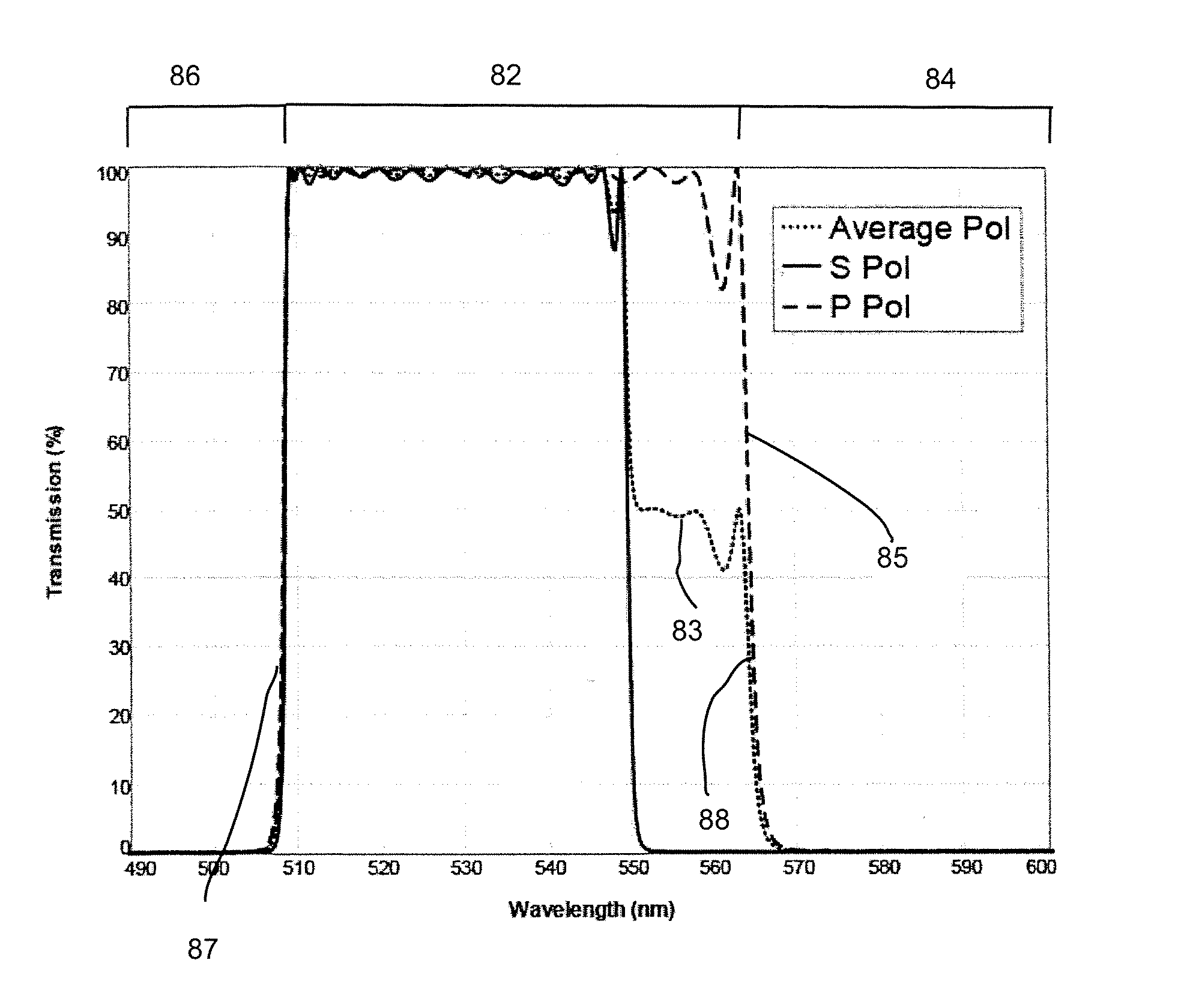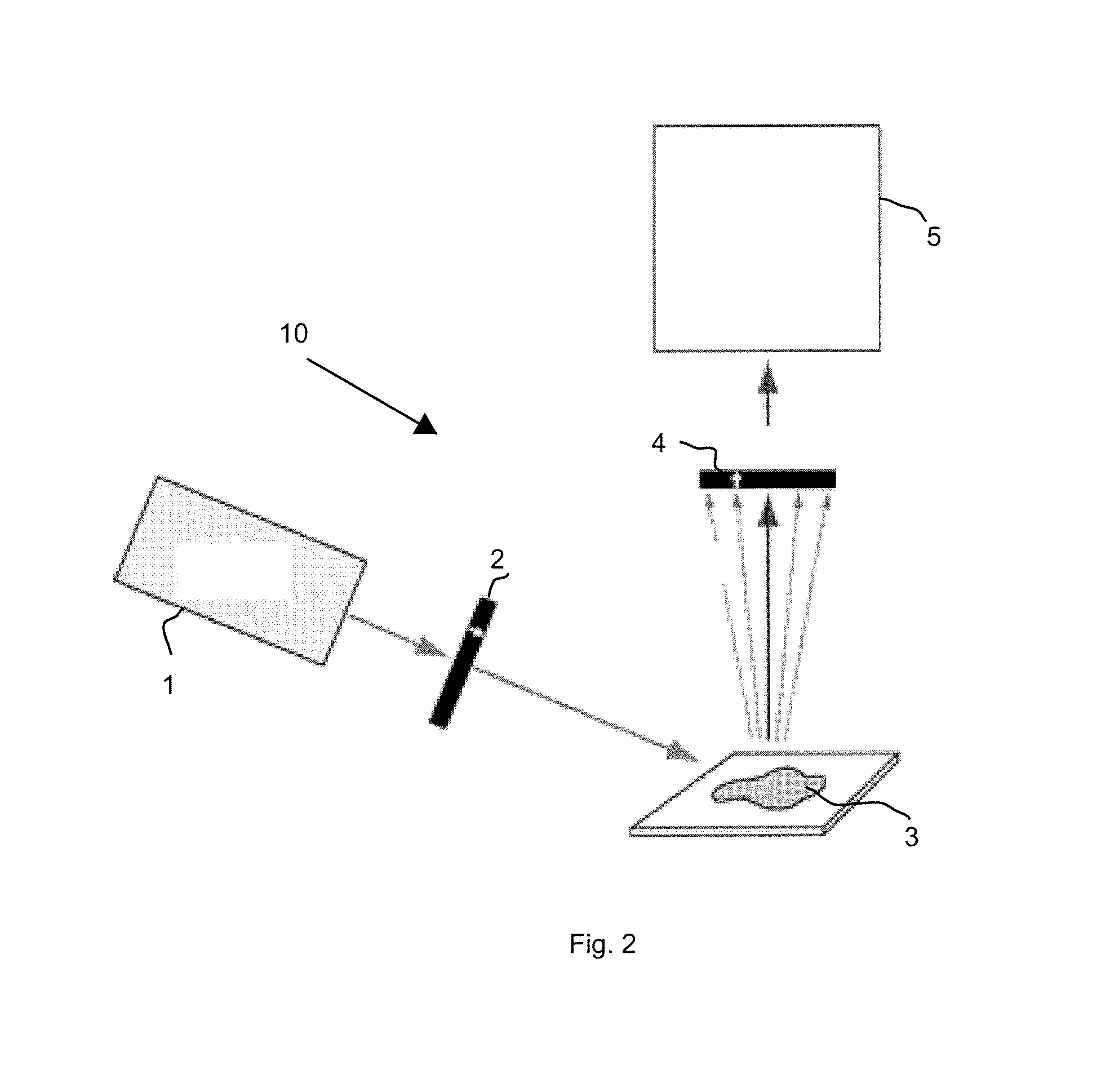Interference filter for non-zero angle of incidence spectroscopy
a technology of interference filter and incidence spectroscopy, which is applied in the field of interference filter for non-zero angle incidence spectroscopy, can solve the problems of insufficient performance of filter, fatal to the operation of the system in which it is utilized, and real filters have some amount of transmission loss, so as to improve the performance characteristics and improve the polarization splitting
- Summary
- Abstract
- Description
- Claims
- Application Information
AI Technical Summary
Benefits of technology
Problems solved by technology
Method used
Image
Examples
examples 1 and 2
Minimal Polarization Splitting, Long Wave Pass Steep Edge Dichroic Filter Configurations Based on the Concept of Passband Defect
[0121]A filter design corresponding to minimal polarization long wave pass steep edge dichroic filter based on the concept of passband defect was produced by optimizing a traditional dichroic short wave pass (SWP) filter spectrum and structure against a design spectrum using well-known optimization algorithms (e.g., the variable metric approach). That is, this design was optimized starting from a dichroic SWP filter comprising a substrate and approximately 150 alternating quarter wavelength thick layers of materials having high and low refractive index at a reference wavelength, respectively, and in view of a target (design) spectrum having desired spectral characteristics.
[0122]In the design spectrum, the edge of the SWP was chosen to be slightly longer than a specified long wavelength edge of the dichroic passband. The passband ripple of the design spectr...
examples 3 and 4
532 nm Steep Dichroic Beamsplitter
[0129]A first 532 nm dichroic beamsplitter optical filter (example 3) was produced having the configuration shown in the following table:
[0130]
TABLE 3Design structure of a 532 nm steep dichroic beamsplitter532 nm Steep Dichroic BeamsplitterCoating Thickness (μm): 14.572006282Total Layers: 92LayerMaterialThickness (nm) 1Nb2O515.76397 2SiO2299.964436 3Nb2O5140.250246 4SiO2191.877075 5Nb2O5127.915529 6SiO2182.984338 7Nb2O5127.387605 8SiO2179.120336 9Nb2O5127.71754210SiO2175.63288811Nb2O5128.59222412SiO2176.38058613Nb2O5128.37391614SiO2178.88728315Nb2O5127.76939916SiO2184.19487817Nb2O5127.9342618SiO2188.22730819Nb2O5128.00575620SiO2188.05713421Nb2O5127.91821622SiO2184.47532123Nb2O5128.07298324SiO2179.42554625 Nb2O5128.14155726 SiO2176.96435527 Nb2O5 127.9697428 SiO2177.50607829 Nb2O5 126.51160430 SiO2178.3360631 Nb2O5122.57701832 SiO2184.03901133 Nb2O5 117.33583734 SiO2194.18907635 Nb2O5 112.22888736 SiO2203.6049937 Nb2O5 106.36272138 SiO2211.47630739 N...
examples 5-7
785 nm Steep Dichroic Beamsplitter
[0137]A 785 nm dichroic beamsplitter optical filter design was produced having the configuration shown in the following table.
[0138]
TABLE 5structure of a 785 nm dichroic beamsplitter785 nm Steep Dichroic BeamsplitterCoating Thickness (μm): 22.027679258Total Layers: 102LayerMaterialThickness (nm) 1Nb2O532.65508 2SiO2144.868199 3Nb2O547.804313 4SiO2128.394549 5Nb2O5238.282792 6SiO2278.529226 7Nb2O5205.569093 8SiO2192.698961 9Nb2O5213.37000410SiO2229.79832411Nb2O5202.3180412SiO2229.54052813Nb2O5188.95296914SiO2264.18647715Nb2O5166.66879716 SiO2298.76361117 Nb2O5151.80093718 SiO2306.54067119 Nb2O5153.74393920 SiO2292.51953821 Nb2O5167.7765422 SiO2265.66501323 Nb2O5181.80545224 SiO2248.08595425 Nb2O5186.58791626 SiO2257.08303527 Nb2O5173.73124928 SiO2282.19076329 Nb2O5159.39777130 SiO2300.39195331 Nb2O5150.9652632 SiO2297.93649533 Nb2O5162.27664734 SiO2278.17171935 Nb2O5176.66888936 SiO2253.86304537 Nb2O5184.79206838 SiO2254.29953539 Nb2O5177.74686140 Si...
PUM
 Login to View More
Login to View More Abstract
Description
Claims
Application Information
 Login to View More
Login to View More - R&D
- Intellectual Property
- Life Sciences
- Materials
- Tech Scout
- Unparalleled Data Quality
- Higher Quality Content
- 60% Fewer Hallucinations
Browse by: Latest US Patents, China's latest patents, Technical Efficacy Thesaurus, Application Domain, Technology Topic, Popular Technical Reports.
© 2025 PatSnap. All rights reserved.Legal|Privacy policy|Modern Slavery Act Transparency Statement|Sitemap|About US| Contact US: help@patsnap.com



